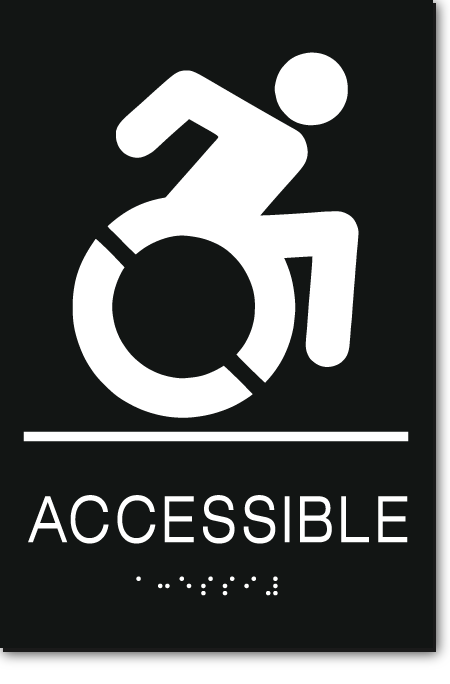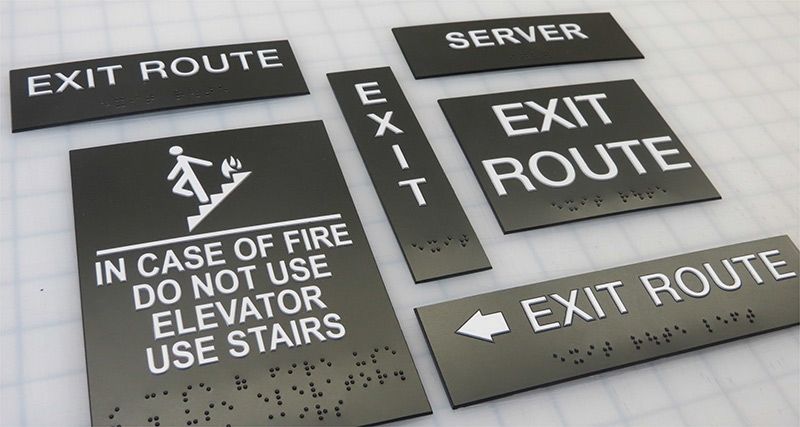The Duty of ADA Signs in Complying with Accessibility Criteria
The Duty of ADA Signs in Complying with Accessibility Criteria
Blog Article
Discovering the Trick Attributes of ADA Signs for Improved Access
In the world of access, ADA signs function as quiet yet effective allies, making certain that rooms are accessible and inclusive for individuals with impairments. By integrating Braille and responsive elements, these indications break obstacles for the aesthetically damaged, while high-contrast shade schemes and legible font styles provide to diverse aesthetic needs. Their critical positioning is not approximate however instead a calculated effort to assist in seamless navigating. Yet, beyond these features exists a deeper narrative regarding the evolution of inclusivity and the continuous commitment to developing fair spaces. What a lot more could these signs symbolize in our search of universal accessibility?
Value of ADA Conformity
Making sure conformity with the Americans with Disabilities Act (ADA) is important for promoting inclusivity and equal accessibility in public rooms and offices. The ADA, established in 1990, mandates that all public centers, employers, and transportation solutions fit people with impairments, guaranteeing they enjoy the exact same legal rights and possibilities as others. Conformity with ADA standards not only fulfills lawful obligations however likewise enhances a company's online reputation by showing its commitment to diversity and inclusivity.
One of the crucial facets of ADA conformity is the application of easily accessible signs. ADA indicators are developed to make certain that individuals with disabilities can quickly browse via structures and spaces.
Additionally, sticking to ADA laws can alleviate the danger of possible fines and legal effects. Organizations that stop working to follow ADA guidelines may face charges or legal actions, which can be both economically burdensome and damaging to their public picture. Therefore, ADA conformity is essential to fostering a fair environment for everybody.
Braille and Tactile Aspects
The unification of Braille and tactile aspects right into ADA signage personifies the concepts of access and inclusivity. It is typically positioned underneath the equivalent message on signs to make sure that individuals can access the information without aesthetic support.
Tactile components prolong beyond Braille and include increased signs and personalities. These parts are created to be discernible by touch, permitting individuals to recognize room numbers, toilets, leaves, and other critical locations. The ADA establishes certain guidelines regarding the dimension, spacing, and placement of these responsive aspects to optimize readability and make certain uniformity across various settings.

High-Contrast Color Schemes
High-contrast color design play an essential role in improving the exposure and readability of ADA signs for individuals with visual impairments. These systems are vital as they maximize the difference in light reflectance between message and history, ensuring that indications are quickly discernible, even from a distance. The Americans with Disabilities Act (ADA) mandates the usage of certain shade contrasts to suit those with minimal vision, making it an essential aspect of conformity.
The efficacy of high-contrast colors depends on their capacity to stand apart in various lighting problems, including dimly lit atmospheres and areas with glow. Usually, dark text on a light background or light text on a dark background is employed to attain ideal contrast. Black message on a yellow or white background gives a plain aesthetic difference that helps in fast recognition and understanding.

Legible Fonts and Text Size
When considering the style of ADA signage, the option of legible fonts and proper text dimension can not be overemphasized. The Americans with Disabilities Act (ADA) mandates that fonts need to be not italic and sans-serif, oblique, manuscript, extremely directory attractive, or of unusual type.
The dimension of the message additionally plays a crucial role in ease of access. According to ADA standards, the minimum message height should be 5/8 inch, and it should increase proportionally with checking out range. This check my blog is particularly vital in public spaces where signage requirements to be checked out quickly and properly. Consistency in text dimension adds to a natural aesthetic experience, aiding people in browsing atmospheres successfully.
Furthermore, spacing between letters and lines is essential to clarity. Appropriate spacing stops characters from showing up crowded, enhancing readability. By adhering to these criteria, designers can considerably improve ease of access, guaranteeing that signage serves its intended purpose for all people, no matter of their visual capabilities.
Reliable Placement Strategies
Strategic placement of ADA signage is essential for optimizing availability and ensuring compliance with legal criteria. Correctly positioned signs assist people with disabilities efficiently, facilitating navigation in public rooms. Secret considerations consist of height, presence, and distance. ADA standards specify that signs must be installed at an elevation in between 48 to 60 inches try this site from the ground to ensure they are within the line of view for both standing and seated people. This common elevation array is important for inclusivity, making it possible for mobility device individuals and people of varying heights to gain access to details effortlessly.
Furthermore, indicators must be placed beside the latch side of doors to allow easy identification before entry. This placement aids people situate rooms and areas without blockage. In situations where there is no door, indicators should be located on the nearby nearby wall. Uniformity in sign placement throughout a center enhances predictability, reducing complication and enhancing general user experience.

Final Thought
ADA signs play a crucial function in advertising accessibility by integrating attributes that attend to the requirements of individuals with specials needs. These aspects jointly cultivate an inclusive setting, highlighting the relevance of ADA compliance in guaranteeing equivalent gain access to for all.
In the world of ease of access, ADA indications offer as quiet yet effective allies, ensuring that rooms are accessible and comprehensive for individuals with impairments. The ADA, enacted in 1990, mandates that all public centers, employers, and transport services suit individuals with specials needs, guaranteeing they take pleasure in the exact same civil liberties and chances as others. ADA Signs. ADA signs are made to ensure that people with impairments can easily navigate via buildings and rooms. ADA guidelines stipulate that signs need to be installed at a height between 48 to 60 inches from the ground to ensure they are within the line of view for both standing and seated people.ADA indicators play an essential duty in advertising ease of access by incorporating functions that address the requirements of individuals with disabilities
Report this page